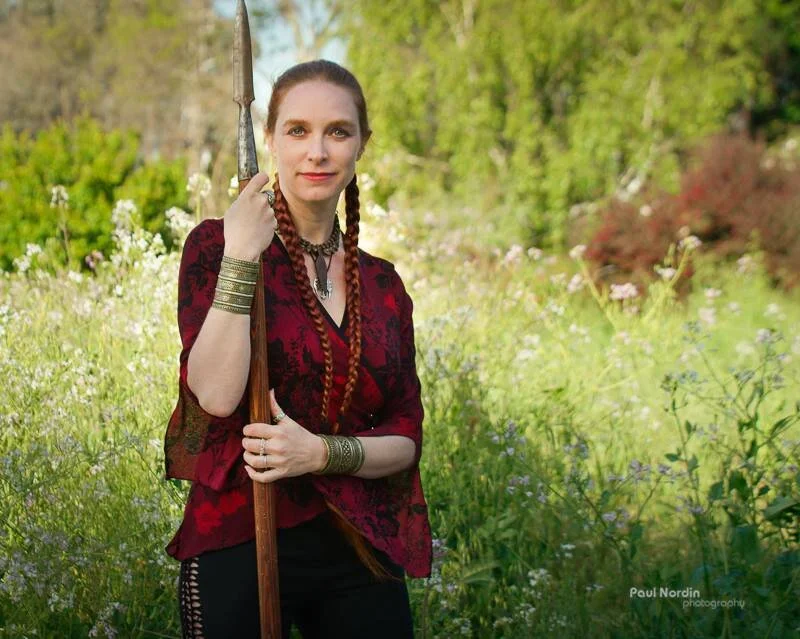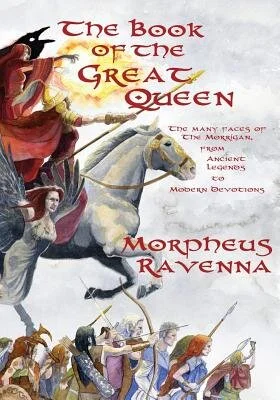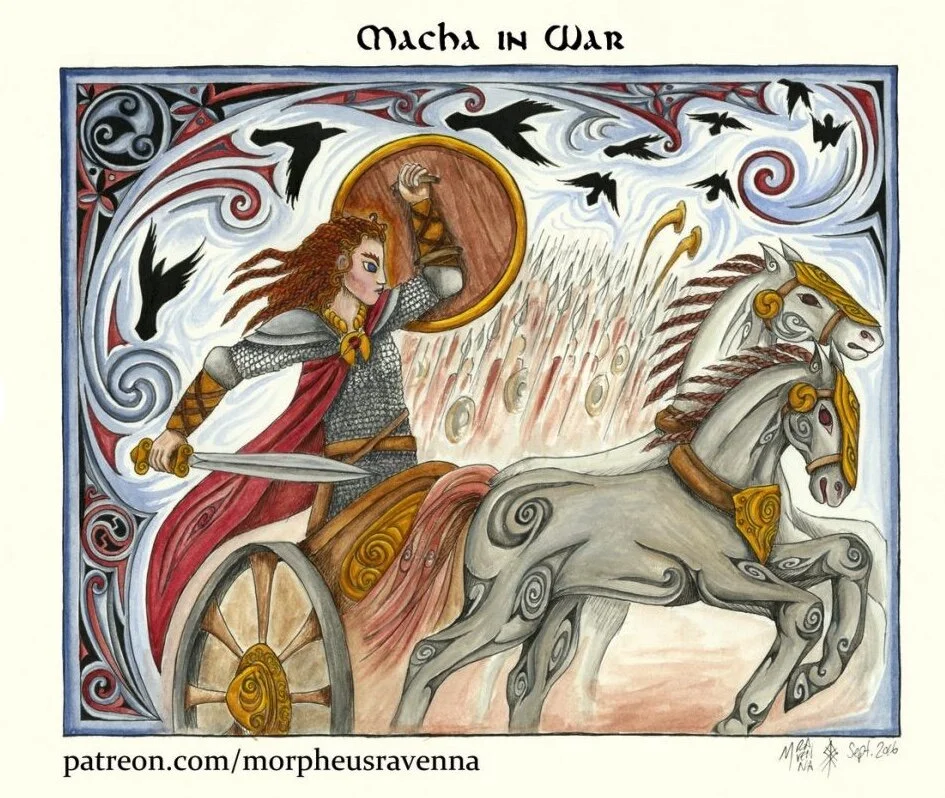As Dark Moon approaches, we thought we’d explore a Celtic approach. While many folks work with Hekate at Dark Moon, we reached out to Oakland-based local artist, author, and priest of the Morrigan Morpheus Ravenna, to get her take on Dark Moon practice.
Here, Sharon Knight interviews Morpheus for our readers.
Sharon: Does the Morrigan have any Dark Moon practices or associations that you know if?
Morpheus: A lot of people do associate the Morrigan with the Dark Moon. It’s not so much a reflection of her being specifically associated with the Dark Moon as it is that the kind of energy and “spiritual weather” that occurs at the Dark Moon is compatible with where she sits, and what her functions and roles are; because it’s a good time for cleansing and releasing, and even destroying, sometimes.
Sharon: Do you yourself do any Dark Moon practices?
Morpheus: I don’t work with the Morrigan specifically in relation to the Dark Moon, but it is often a time when I do cleansing and purification practices, and I will often also do divination at that time. It is the start and end of a cycle, which is a good time for those types of practices.
Sharon: Do you think of the Morrigan as a Dark Goddess?
Morpheus: That is something you hear a lot. In terms of the lore she arises from, like the medieval Irish texts, it’s a mixed picture; she’s associated with battle and victory and some of the forces that surround her could be characterized as dark in the sense that they’re associated with violence, but not necessarily darkness as in the absence of light.
One thing we have to ask is, are we talking about dark in the sense of morally or spiritually?
Sharon: what about the aspect of her that deals with the Dead, like the queen of the phantoms, and ferrying Dead souls to the underworld? That’s what I think of when I think of dark.
Morpheus: There is one particular medieval poem that speaks of her haunting the battlefield in the aftermath. She comes and washes the entrails of the Dead, and she is described as being accompanied by specters, and the “Terrors of the Night”.
Sharon: Like the Washer at the Ford?
Morpheus: The Washer at the Ford is more of a role than a specific being. The Morrigan can step into this role in delivering an omen, but she is not the only one who does so. Sometimes it is the Morrigan, sometimes it is Badb (pronounced Bive), and sometimes it’s not exactly clear who the Washer is, but she appears as an omen that you will die in the upcoming battle.
Sharon: I have seen somewhere that the Washer is washing the soul from the body.
Morpheus: That would be a more modern take on it. The descriptions in the lore depict her as washing blood from armor, clothing, or sometimes a body. That said, I wouldn’t call The Morrigan a “Dark Goddess” per se; she does have an association with specters that appear in the night but she also has associations of brightness, such as victory, and the Hero’s Light.
Sharon: Could you talk about the Hero’s Light a little bit?
Morpheus: Sure! I should probably add as a caveat that the Morrigan is part of a complex of Goddesses, and some of these associations cross over. So the Hero’s Light is more associated with Badb, who is sometimes described as the Morrigan’s sister, and sometimes they are treated as interchangeable.
The Hero’s Light is a translation of an Irish phrase that refers to an emergent spiritual phenomenon that occurs when warriors are in a state of elevated rage and passion, a battle fury that they enter in order to access their courage, and become unstoppable. These spiritual phenomena are described as lights or torches over a warrior’s head, or a bird that flutters from their head or emerges from their breath, or sparks or clouds, even pillars of light. Some of these phenomena are monstrous, such as fountains of blood.
Sharon: Is this perceived as an outside spiritual force or as coming from within the warrior?
Morpheus: It is described as emerging from the warrior’s breath, but also, it is associated with visitations of the war goddesses. It is sometimes described in terms of a bird that is fluttering over their head, and that, to me, suggests that it’s a visitation from a spiritual entity. One of my theories about it is that we are talking about an in-dwelling presence which emerges when they enter the state of battle fury.
Sharon: How would you suggest approaching the Morrigan?
Morpheus: You can begin at whatever pace you are comfortable with. Many people find the Morrigan intense, and sometimes demanding or overwhelming, and it is okay to set boundaries, and take the relationship one step at a time.
With any devotional relationship, a good place to begin is to create a space from which to make offerings, and to honor them. Especially if you are trying to establish a new relationship, where it has not yet really been forged, it is helpful to be regular with devotional practice. Daily practice is good, but if not daily, at least on some really regularly recurring pattern, to give the relationship a chance to establish itself.
Sharon: How does your artwork interact with your spiritual practice?
Morpheus: The two are really closely intertwined. A lot of the subjects that I choose to make art about are driven by my spiritual practice. I’ve always had a big love of mythology and mythical beings, so I do a lot of art that’s inspired by those stories, and by my sense of devotion. I grew up surrounded by a lot of imagery and cultural features associated with Hinduism, which has this really rich tradition of devotional art, and very loving depictions of their deities. I suppose I adopted a love of that kind of devotional art. More than anything else, I really love to do mythical beings, and that sort of thing.
Sharon: Do you find that it helps to deepen your understanding of the beings, and your spiritual practice?
Morpheus: I do. For me, creating art of a deity or a spirit, or that is inspired by one of their stories, is like a doorway for me to enter into exploring that being. I will follow feelings that arise as I am doing the work, a certain look or effect that really moves me in the moment, that feels like something is coming to life. As I follow those instincts I find that it reveals something; a face, or a way of seeing that being that wouldn’t have occurred to me before.
Sharon: What have you learned in 2020 with all of its challenges? How has it changed your practice? Spiritual approach?
Morpheus: We are definitely doing more online rituals than I am used to. I have never been really into online rituals, because for me ritual is a very embodied experience, so trying to share that experience over a Zoom connection was never going to be my first choice. But at the same time I am finding that it is prompting me to share ritual space with people that I wouldn’t otherwise have been doing so with.
Sharon: Yeah folks aren’t geographically limited from attending now. You can reach more people.
Morpheus: Yeah. Also, I think one of the really big messages from this year is that solidarity is what’s going to save us, in so many ways, and so practicing a broader solidarity, where we are connecting with people from all over the place that are sharing these experiences and struggles that we’re in, feels really important. That’s powerful, and I feel that we should be leaning into that solidarity.
Would you like to learn more about the Morrigan? Morpheus wrote a book called “The Book of the Great Queen”, which is an excellent resource for both lore and practice!
Want to see this book at our Bookshop.org site?
Would you like to learn more about Morpheus’ art, and perhaps get a devotional tattoo? You can learn more about Morpheus’ work at https://bansheearts.com



